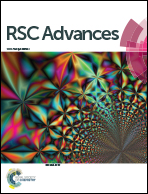Perfluoroalkylated alternating copolymer possessing solubility in fluorous liquids and imaging capabilities under high energy radiation†
Abstract
A highly fluorinated alternating polymer, P(RFMi-St), possessing improved thermal properties and patterning capabilities over perfluoroalkyl polymethacrylates under high energy radiation was achieved with semi-perfluorododecyl maleimide (RFMi) and styrene (St). RFMi could be synthesised efficiently via a Mitsunobu reaction condition and copolymerised with St by free radical and reversible-deactivation radical polymerisation protocols. P(RFMi-St) showed a satisfactory glass-transition temperature (108 °C) and intermolecular cross-linking behaviour under electron-beam and commercially more important extreme UV (λ = 13.5 nm) irradiation. The exposed regions lost their solubility, resulting in the successful formation of mechanically non-deteriorated negative-tone images down to 50 nm. In addition, P(RFMi-St) could be solution-processed with chemically non-damaging fluorous liquids, which enabled the polymer to be applied effectively on top of an organic semiconductor layer as a dielectric material (dielectric constant 2.7) for the organic field-effect transistor fabrication.



 Please wait while we load your content...
Please wait while we load your content...